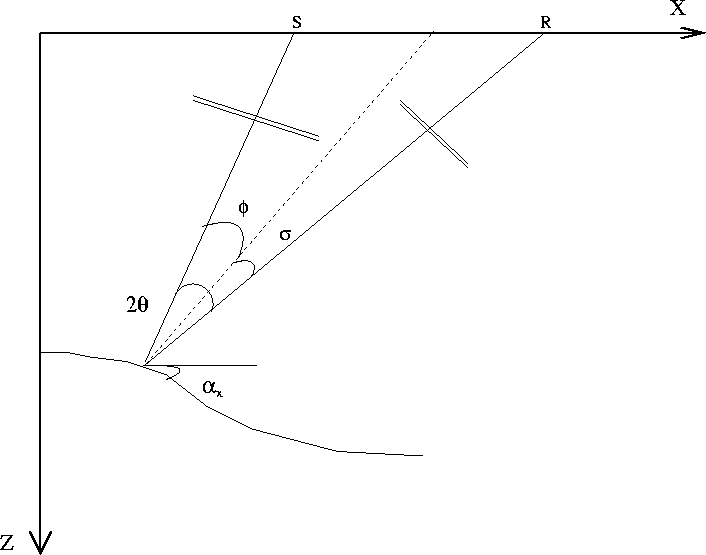
![[*]](http://sepwww.stanford.edu/latex2html/cross_ref_motif.gif) describes the angles we use in this section.
For the converted-mode case, we define
the following angles:
describes the angles we use in this section.
For the converted-mode case, we define
the following angles:
 |
||
| (3) |
|
angles
Figure 1 Definition of angles for the converted-mode reflection experiment. The angles |  |
The main goal of this paper is to obtain a relationship between the known quantities from
our image, ![]() and the full-aperture angle (
and the full-aperture angle (![]() ).
Appendix A presents the full derivation of this relationship. Here, we present only
the final result, its explanation and its implications.
The final relationship we use to obtain converted-mode angle-domain common-image
gathers is the following (Appendix A):
).
Appendix A presents the full derivation of this relationship. Here, we present only
the final result, its explanation and its implications.
The final relationship we use to obtain converted-mode angle-domain common-image
gathers is the following (Appendix A):
| |
(4) |
this equation consists of three main components: ![]() is the
P-to-S velocity ratio,
is the
P-to-S velocity ratio, ![]() is the pseudo-opening angle,
and
is the pseudo-opening angle,
and
![]() is the field of local step-outs of the image.
Equation 4 describes the transformation from
the subsurface-offset domain
into the angle domain for converted-wave data.
This equation is valid under the assumption of constant velocity. However, it
remains valid in a differential sense in an arbitrary-velocity medium, by
considering that
is the field of local step-outs of the image.
Equation 4 describes the transformation from
the subsurface-offset domain
into the angle domain for converted-wave data.
This equation is valid under the assumption of constant velocity. However, it
remains valid in a differential sense in an arbitrary-velocity medium, by
considering that ![]() is the subsurface half-offset. Therefore, the limitation of
constant velocity applies in the neighborhood of the image. For
is the subsurface half-offset. Therefore, the limitation of
constant velocity applies in the neighborhood of the image. For ![]() ,
it is important to consider that every point of the image
is related to a point on the velocity model with the same image coordinates.
,
it is important to consider that every point of the image
is related to a point on the velocity model with the same image coordinates.